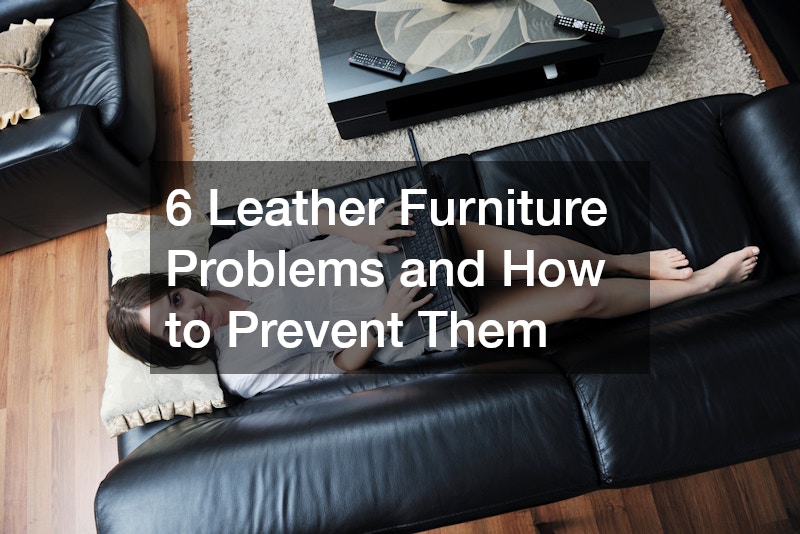Investing in leather furniture can elevate the look and feel of your home, offering timeless beauty and luxurious comfort. However, while leather is prized for its durability, it isn’t immune to wear and tear. Whether it’s body oil damage, color fading, or cracking, your leather sofa or chair can develop issues over time.
The good news is that with a little care and attention, you can prevent many of these common problems and extend the life of your furniture. Here are the top six issues leather furniture owners face—and how to combat them.
1. Protect Your Leather From Body Oil Damage
Leather is a naturally absorbent material, and one of the most common problems it faces is damage from body oils and perspiration. Over time, these oils can seep into the leather, causing discoloration and eventually leading to cracks or peeling. This is especially common in areas that come into regular contact with skin, such as armrests, headrests, and seats.
How to Prevent It:
To keep your leather furniture looking pristine, regular cleaning is essential. Use a soft cloth to gently wipe down the surfaces, and opt for a leather-safe cleaner to remove any buildup of body oil. Depending on how frequently the furniture is used, a monthly wipe-down may be sufficient, but high-use areas might need more frequent attention.
2. Guard Against Color Fading
Much like fabrics, leather is prone to fading when exposed to direct sunlight or heat sources. Ultraviolet (UV) rays can cause leather to lose its rich color over time, leaving your furniture looking dull and worn. Heat from nearby fireplaces, radiators, or furnaces can also speed up this process.
How to Prevent It:
To minimize the risk of fading, avoid placing your leather furniture in areas where it will be exposed to direct sunlight. Consider positioning your sofa or chairs away from windows, or invest in UV-blocking curtains or window treatments. For added protection in spaces where heat is a concern, you might also consider professional double glazing for your windows. This can help reduce the amount of UV light and heat entering the room, preserving your furniture’s color for longer. Additionally, refrain from putting leather furniture too close to heat sources like fireplaces or heaters, as this can further accelerate color loss.
3. Prevent Cracking With Proper Care
Leather furniture, especially in climates that fluctuate between hot, dry winters and humid summers, is susceptible to cracking. When leather dries out, it loses its natural oils, becoming brittle and prone to cracking. Over time, this cracking can worsen and may lead to peeling or further damage.
How to Prevent It:
The key to preventing cracking is moisture. Regular conditioning of your leather helps to keep it hydrated and supple. Use a leather conditioner designed to restore natural oils and keep your upholstery from drying out. This should be done a few times a year, depending on the environment your furniture is in. Avoid placing leather near windows or heating vents to reduce exposure to the elements that cause it to dry out.
4. Stop Peeling Before It Starts
Once leather starts to peel, it’s nearly impossible to repair. Peeling occurs after the leather has suffered significant damage, often due to a combination of cracking and the breakdown of the leather surface. Friction from regular use can then cause the leather to lift and peel away from the furniture.
How to Prevent It:
To avoid peeling, take proactive steps to prevent cracking, as the two issues often go hand in hand. Keep your leather furniture clean and conditioned, and place it in a location where it won’t be exposed to excessive heat or direct sunlight. If you notice the beginnings of wear or cracks, treat the leather immediately to prevent further damage. Unfortunately, once peeling occurs, the best solution may be to reupholster the piece or seek professional restoration services.
5. Reduce the Impact of Leather Smell
The smell of leather can be polarizing—some people love it, while others find it overpowering. Natural leather has a distinctive odor that can linger in a room, especially when the furniture is new. For those who are sensitive to strong smells, this can be an unwelcome side effect.
How to Reduce It:
If you or someone in your household is sensitive to the smell of leather, the best way to reduce it is to ventilate the room. Open windows and use fans to keep air circulating, which will help the smell dissipate faster. The odor will naturally fade over time, but proper ventilation can speed up this process. Moreover, using a mild fabric refresher spray designed for leather can help neutralize the scent without damaging the material.
6. Understand Leather Loosening and Puddling
Over time, leather upholstery can start to lose its tautness, leading to a phenomenon known as “puddling.” This occurs when the leather and the underlying foam lose their shape, causing the surface to appear loose or wrinkled. While some degree of loosening is inevitable with regular use, it can make furniture look older and less maintained.
How to Prevent It:
While you can’t completely prevent leather from loosening over time, choosing high-quality, dense cushions can help slow down the process. Denser cushions are less likely to lose their shape, which means the leather will stay tighter for longer. If puddling has already started, consider re-stuffing the cushions or replacing the foam to give the furniture a refreshed appearance.
Choosing the Right Leather for Longevity
Not all leather is created equal, and the type of leather you choose can significantly impact how susceptible it is to the problems outlined above. Higher-grade leathers tend to be more durable and resistant to wear, while lower-grade or combination leathers may be more prone to cracking, peeling, and fading.
When shopping for leather furniture, take the time to understand the different kinds of leather available. For example, full-grain leather is the highest quality and offers the best durability and aging properties. Split-grain leather, on the other hand, may be more affordable but is often more susceptible to wear and tear.
Closing Thoughts
Leather furniture is a long-term investment, and with the proper care, it can last for decades. By understanding the most common problems associated with leather and taking steps to prevent them, you can keep your furniture looking beautiful and feeling comfortable for years to come.
Regular cleaning, conditioning, and thoughtful placement within your home are the keys to preserving the quality of your leather upholstery. Whether you’re already a proud leather furniture owner or considering your first purchase, these tips will help you protect your investment and enjoy the luxury of leather for the long haul.
.



